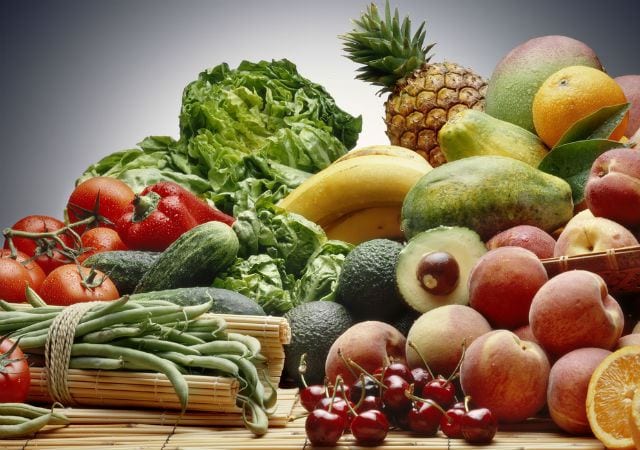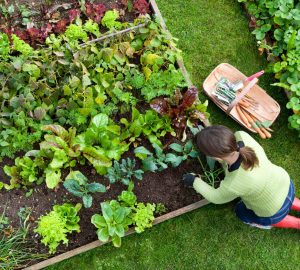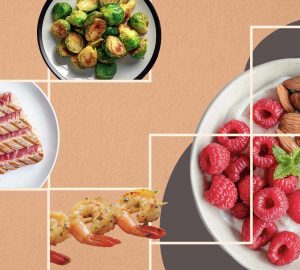We all know that “Vegetables and Fruit” is a food group on the Canada Food Guide, but you probably call it “Fruit and Vegetables”. I often wonder if that little switcheroo in how we name it has a psychological connection to the fact that most people prefer to eat fruit over vegetables most of the time, if given a choice. This fact is what leads me to our topic today.
MOST PEOPLE ARE GROSSLY DEFICIENT IN THEIR VEGETABLE INTAKE.
Vegetables are the second most nutrient-dense food source on the planet (after organ meat), offering us an extremely wide array of essential nutrients like vitamins, minerals, and compounds like antioxidants that help us stay healthy. Yet it’s the food group we ignore the most, especially the vegetables part. Eating nutrient-dense foods is really important in order for us to get enough nutrition for our body to operate optimally. This is especially important over the longer term because it’s over the long term that nutrient deficiencies can occur. The other way to say it is that if you continuously avoid this food group, you may be putting yourself at risk of a vitamin or mineral deficiency, which could then lead you down the path to health complications, illness, or disease. None of us really want that, do we?
I suggest this way to get our best bang from vegetables: eat a large amount and a wide variety, both raw and cooked using different cooking methods. Contrary to advice from many mainstream nutritionists and dieticians, I don’t support going along with every component of the Canada Food Guide, but I do believe their advice on Vegetables and Fruit is good. It suggests having at least one dark green and one orange vegetable each day, to choose healthier cooking methods, and to have whole vegetables and fruit more often than juice. To make this advice even more valuable, it can be expanded a bit. To further clarify my perspective on this, we should eat a rainbow of coloured vegetables over the course of a week, avoid deep-fried vegetables and those cooked in oils that are highly refined and have a low smoke point, and avoid juice that comes from the grocery store.
I’m going to share my best tips for how to increase vegetable intake later on but first, let’s talk about fruit a bit. This is an area that can be controversial in the nutrition industry and I’m comfortable standing near one end of the spectrum. Fruit is not as nutrient dense as vegetables are. While they can offer some valuable nutrition to us, they simply don’t offer the same wide array of nutrients that vegetables do. Where fruit can shine is in their high levels of antioxidants, little disease-fighting and anti-inflammatory helpers. Almost all berries are superstars in regards to their antioxidants.
The downside of fruits is where we get into some controversial territory. Fructose is fruit sugar. In my book, sugar is sugar is sugar, no matter where it comes from, and too much of it is a bad thing. One of the arguments I come across in favour of fructose is that it’s digested by the body differently than other sugar, and this makes it healthier or not as bad for us. It’s true that fructose is dealt with differently in the digestive system. Fructose is shuttled off to the liver for repackaging before it can be absorbed into the bloodstream, which delays its impact on blood sugar levels. I guess you could say that when you eat fruit, it’s more of a time-release of blood sugar. I have two main objections to those that eat a lot of fruit that think they’re eating healthy sugar.
My first objection comes from what I just explained above – the liver’s role in digesting fructose. The liver has a lot of really important functions in the body and is an organ that we should all be taking better care of. It creates bile, a major compound of fat digestion. It also filters the blood of toxins that we expose our bodies to. Due to how many toxins we’re subjected to on a daily basis, this job alone keeps the liver really busy. If we overload the body with fructose, we’re really just stressing out our liver even more when it has other more important things to do. The liver isn’t indestructible. There’s an alarming trend emerging these days that really worries me in terms of liver health. There are more and more diagnoses of a chronic disease called Non-Alcoholic Fatty Liver Disease. NAFLD was once considered an adult disease but it’s now being increasingly diagnosed among children and adolescents. NAFLD is caused primarily by being constantly bombarded by insulin. Insulin is the hormone the body releases to bring down increased blood sugar. While refined sugar in the diet is more likely the cause of NAFLD than fructose is, fructose does still elicit an insulin response from the body, therefore it does contribute to the problem.
My second objection is a bit simpler to explain. Excess sugar that isn’t needed by the body for immediate fuel will eventually be stored as fat. Food is composed of three macronutrients: protein, fat, and carbohydrates. Carbohydrates are composed of simple or complex carbohydrates, which all break down into simple sugars in the body. An excess of any of the three macronutrients in the diet can actually be stored in the body as fat if it isn’t needed for fuel. So yes, even too much fruit can lead to fat storage, especially in people that are consuming a lot of other sources of sugar. I can hear your hearts breaking. I’m sorry to be the bearer of bad news.
Below are recommendations for how many servings of Vegetables and Fruit are recommended for adults based on age and gender in the Canada Food Guide:
Females aged 19-50: 7-8
Females aged 51+: 7
Males aged 19-50: 8-10
Males aged 51+: 7
I suggest focusing on vegetables with a serving or two of fruit per day. A serving is not too tricky to measure. 1 cup of raw leafy vegetables is 1 serving, but if you cook them then ½ cup cooked is a serving. A ½ cup of fresh, frozen, or canned vegetables and fruit is one serving. One piece of whole fruit like an orange or medium banana is one serving, unless it’s a larger piece.
Here are my best tips on how to increase vegetable intake:
- Juice them – the best way to get a veritable mountain of veggies into your diet is to juice them. Your glass will be full of energizing nutrients that are quickly absorbed into your bloodstream because there’s not much fibre to slow down digestion. Lack of fibre isn’t a worry for those that eat a high-fibre diet the rest of the time. Be sure of two things when juicing – to only juice with organic produce or otherwise the concentrated pesticide load could be counter-productive to your health, and be sure that when you juice, your vegetables outweigh your fruit, otherwise you’ll end up with too much sugar in your drink. Simply adding in homemade juices can really be a big positive change for some people.
- Snack on them – washing and preparing raw vegetables when you get home from grocery shopping can save you a lot of time during the week. Having peeled carrots, cucumber, celery, cherry tomatoes, radishes, and other fresh veg ready to go makes grabbing a serving or two for a daily snack easy.
- Eat salad – okay, I’ll admit that I’m not a natural-born salad fan, and some of you reading this feel the same. Let’s hug it out. Now let’s suck it up. The long term gain is far more valuable than the cost of the short term discomfort. Vary your greens and the additional veggies, add some raw nuts and seeds, and vary your homemade dressing. That’s right, I did say homemade dressing. Once you practice a bit, homemade dressings are easy and soon you won’t even need a recipe to make them. Using a store-bought dressing really decreases the healthy quotient of your salad. Consider having just a big salad for supper sometimes. All that chewing will tire you out and all the fibre should fill you up.
- Add veggies to pasta sauce. Whether you make your own sauce or use store-bought sauce, throw in a few diced veggies like onion, zucchini, mushrooms, and grated carrot. Yum!
- Soup – there are tones of soups you can make at home, from quick and easy to more complicated ones. Blending or pureeing them after cooking sometimes helps those that don’t really like the texture of cooked vegetables to still eat them with all their wonderful flavour and benefits.
- Smoothies – many people are now making smoothies in the morning as a quick breakfast meal. Most of the time there’s a lot of fruit and little to no vegetables inside. Try adding some leafy greens. Start with spinach and then once you’re used to that, try beet greens or kale. You don’t need to add a lot, just a cup or so.
- Balance your meals – adjust how you serve your meals so that half of your plate is vegetables. For each meal, I usually have two, like carrots and broccoli, or beets and asparagus. Don’t rely too heavily on starchy vegetables like potatoes and roots; make sure to include a good portion of non-starchy vegetables in your diet too.
Consider purchasing organic produce, at least some of the time, and always if you’re going to make juice at home. We’re exposed to a lot of toxins in our environment and food supply https://pharmacieinde.com. Our bodies don’t know how to process them so they end up accumulating in the body, with the potential to cause major problems down the road. I think it’s a really good idea to learn some more about the topic and then decide where you stand from the perspective of your family’s long term health. EWG’s Dirty Dozen and Clean Fifteen lists can be a great tool to help choose which items to spend more money on to get the organic varieties, while other people decide to get as much organic produce as possible.
My last note is simply a caution to slowly increase your vegetable intake over time. Vegetables offer us a lot of fibre, which isn’t easily broken down by the body. You can notice slight changes in your digestion, such as a bit of bloating or gas, and changes in your bowel movements. Incorporating changes over time will help your body adjust well to its new healthier diet.
Randi Hawley is a Nutritionist and Group Exercise Instructor living in Edmonton. Her work empowers her fellow humans to be engaged in making positive sustainable changes in their health and wellness. She can be reached at realfoodwellnessyeg@gmail.com.








